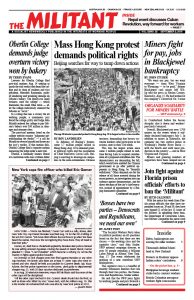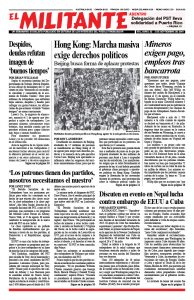Debts and bankruptcies are soaring for working people over age 65. Bosses have held wages down for years and governments have gone after social benefits workers won in struggle in decades past, with a disastrous impact on elderly workers.
According to a 2018 report titled “Graying of U.S. Bankruptcy,” one in seven people who file are now aged 65 or older — an almost fivefold increase over 25 years.
And as working people live longer, their conditions become more dire. In 1989 one in five persons in the U.S. over 75 were in debt. By 2016, almost half were, according to the U.S. Federal Reserve. Of these there has been a tenfold increase in bankruptcy filings since 1991, up to 3.3%.
Workers face stagnant wages for decades while being hit by rising expenses for health care, housing and education. A quarter of retirees in the U.S. have an annual household income of less than $25,000. And 50% of all U.S. households have less income today than they did 30 years ago.
Health care costs have skyrocketed with increasing numbers of working people forced to shell out higher co-payments and deductions under their insurance plans. Under Medicare, out-of-pocket spending comprises about 20% of one’s income, with dental care, hearing aids and glasses not covered. And a 65-year-old retired couple face about $200,000 in medical payments during their retirement years, the report says.
For decades union officials retreated from the militant struggles that built the industrial unions in the 1930s. They sought to get benefits from individual employers without mobilizing the union ranks to fight for what workers really need — federally funded retirement and health care plans as social protections for all workers.
More and more pension plans that officials negotiated became contingent on the profitability of the bosses. And when the bosses’ profits started to dive, workers’ pension plans went with them.
Many bosses succeeded in eliminating industry-based pensions. They’ve substituted 401(k) plans, which require deductions from workers’ paychecks and are based on speculating with retirement funds on the stock market.
For increasing numbers of workers, contributing a percentage of their wages to 401(k) schemes is becoming more difficult as they need what little they earn just to make ends meet. According to a UBS bank survey, 40% of workers are unable to cover a $400 unexpected expense with cash or savings.
Rising auto, student debts
Also propelling bankruptcies for those over 65 are demands for payments for auto or student loans, including those co-signed with a child or grandchild.
“Suddenly the credit card companies were trying to garnish 25% of my pension,” Freddie Green, 69, a retired auto worker from Pontiac, Michigan, who filed for bankruptcy, told the Financial Times, “and a guy showed up trying to take my son’s car because of a loan I co-signed for him.”
According to the U.S. Consumer Finance Protection Bureau Office of Older Americans, the number of those over 60 with student debt quadrupled between 2005 and 2015, “mostly because they co-signed for children or grandchildren. And 37 percent of federal student loan borrowers aged 65 or older are in default.”
Workers’ struggles in the 1930s won Social Security payments, however inadequate, alongside federal-guaranteed universal unemployment benefits, guaranteed disability compensation, and Aid to Families with Dependent Children, the latter of which the Democratic administration of Bill Clinton eliminated in 1996.
Out of the proletarian-led Black rights battle against Jim Crow segregation in the 1950s and early 1960s, the working class won the extension of Social Security to include health benefits like Medicare for the elderly and Medicaid for workers with very low incomes.
The rulers seek to whittle away if not eliminate these social gains entirely. “The capitalist does not care about the first thirteen years of workers’ lives,” wrote Socialist Workers Party National Secretary Jack Barnes in Capitalism’s World Disorder, “then he cares about our ability to work hard for the next fifty years; then he hopes we die quickly. That coarse attitude is what the rulers try to get layers of the working population to accept as well.”
But workers “cannot think of each other the way capitalists think of us,” Barnes wrote. “We have a different class view, a different moral view of society. Elementary human solidarity is in our interests, not in conflict with them.”

